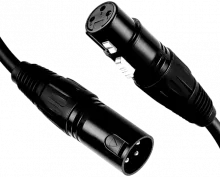
The XLR connector is a type of electrical connector primarily used in professional audio, video, and stage lighting equipment. XLR connectors are cylindical in design, and have three to seven connector pins, and are often employed for analog balanced audio interconnections, AES3 digital audio, portable intercom, DMX512 lighting control, and for low-voltage power supply. XLR connectors are included to the international standard for dimensions, IEC 61076-2-103. The XLR connector is superficially similar to the smaller DIN connector, with which it is physically incompatible.
The XLR connector (also Cannon plug and Cannon connector) was invented by James H. Cannon, founder of the Cannon Electric company, Los Angeles, California. The XLR connector originated from the Cannon X series of connectors in 1915; by 1950, a latching mechanism was added to the connector, which produced the Cannon XL model of connector, and by 1955, the female connector featured synthetic-rubber insulation polychloroprene (neoprene), identified with the part-number prefix XLR. There was also the XLP series of connectors with hard plastic insulation, but the XLR model name is commonly used for all of the variants.
Originally, the ITT Cannon company manufactured XLR connectors in two locations: Kanagawa, Japan, and Melbourne, Australia. The Australian factory was sold to Alcatel Components in 1992 and then acquired by Amphenol in 1998. Later, the Switchcraft corporation manufactured compatible connectors, followed by the Neutrik company, which made improvements to the connector, and produced a second-generation design (the X-series) that had only four parts for the cable connector, and eliminated the small screws used in the models of XLR connectors made by Cannon and Switchcraft.





